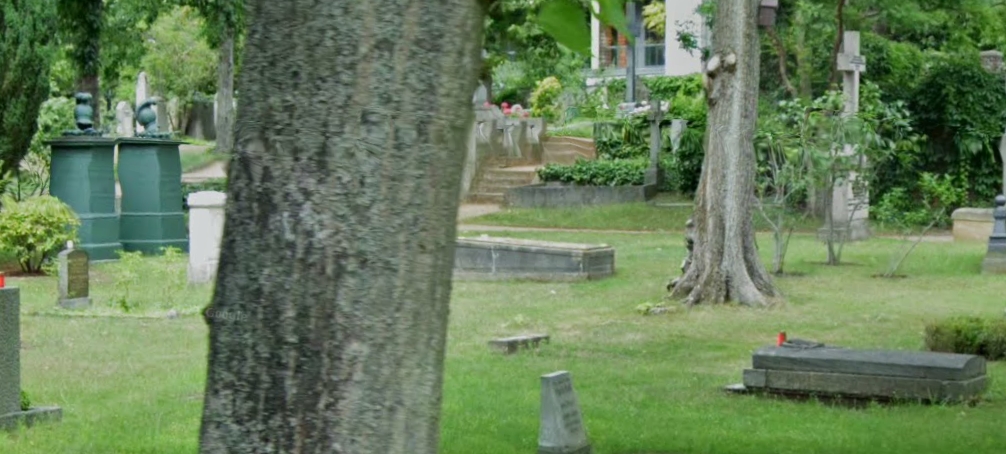Courage
and Bravery in Prague
Operation Anthropoid
: The Assassination of Heydrich
Then out spoke brave Horatius,
the Captain of the Gate:
"To every man upon this earth death cometh soon or late.
And how can man die better than facing fearful odds,
For the ashes of his fathers, and the temples of his Gods?"
- Lord Macaulay, "Horatius"
In 1941 and 1942 several small teams of Czechoslovak parachutists were trained at Cholmondeley Castle and Park in Malpas, Cheshire, UK. These teams were dropped into Czechoslovakia to organise the Czechoslovak Resistance and to orchestrate the assassination of SS-Obergruppenfuhrer Reinhard Heydrich who was the Nazi in command of this area. His savagery and ruthlessness in suppressing the population earned him the name of "The Butcher of Prague". With the support of other small groups of parachutists dropped later, plans were laid to effect the assassination, with the knowledge and support of the exiled Czechoslovak Government in England. At this time, resistance to Nazi rule in what they had called "the Protectorate of Bohemia and Morvia" was subdued, with many Czechs apparently accepting their situation.
There is an excellent in-depth PDF article on Czech Resistance here. It covers all aspects of the subject as well as the Heydrich assassination.
Readers may care to consult the Facebook Group on the Heydrich Story.
Several initial ideas having either failed or proved not feasible, four parachutists, 2/Lt. Adolf Opalka (Commanding Officer), Sgt Jozef Valcik, Sgt Jan Kubis and Sgt Jozef Gabcik, managed on May 27th 1942 to mount an attack on Heydrich's open staff car as his chauffeur drove him through the city outskirts at Holesovice, on the Rude Armady VII Kobylisky as it leads to the Vltava River. Jan was armed with specially modified Type 73 anti-tank grenades and Jozef with a British-issue Sten gun; both also carried .32 Colt automatic pistols. Lookout was being kept by Valchik and Opalka. Heydrich was, unusually, late, but an hour after the expected time, Valcik and Opalka gave the signal that the German staff Mercedes car was approaching. The spot had been carefully chosen at a point where the vehicle must slow right down to negotiate a very steep turn in the road. Heydrich's driver-cum-bodyguard accompanied him. Heydrich often travelled this route independently of his usual armoured escort.
As the car approached and slowed, Jozef Gabcik stepped into the roadway, snatched aside his overcoat, lifted his concealed Sten gun to point at Heydrich and clicked the trigger. It failed to fire. The surprised Germans, believing Jozef was a lone assassin, reacted quickly, braking to a stop and reaching for their weapons. Jan, realising that Jozef's gun had misfired, hurled a grenade which exploded against the right rear wing of the Mercedes car, puncturing the tyre and blowing a large hole in the bodywork. The explosion and grenade fragments severely wounded Heydrich, but both Germans opened fire with their pistols, and the Czechs fled, Jan injured in the head and face by splinters from his own bomb. He was compelled to force his way through Czechoslovak witnesses, some of whom, uncertain of the events, tried to hinder his escape as he fled, waving his pistol, shooting into the air, and hiding his face and injuries. Jozef dropped the jammed Sten gun and fled on foot.
Ironically, Heydrich had only a day or so before ignored a directive that his limousine was to be fitted with armour plate to its bodywork and seats, as he believed that the Czechs had abandoned resistance and that he would soon be recalled to Berlin and assigned other duties. He wanted to assume military control in France.
Whilst the actual assassination site has changed considerably due to road remodelling and building, you can view the area on Google Earth where you can see that the surrounding roads have been named after the Czech team, and there is a link to a Wikipedia article. Photos taken at the time of the assassination pin the site accurately to a factory, still identifiable on Google Earth by shadow cast by its chimney.
Paste 50.118092 / 14.464536 into Google Earth to see the actual site.
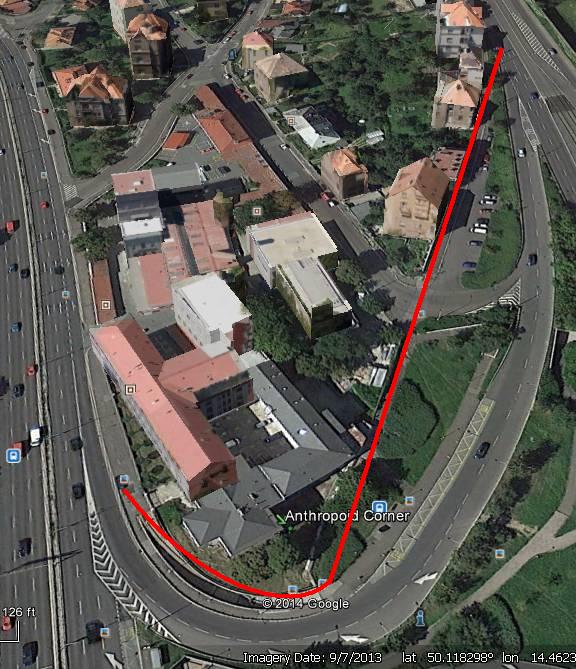 After close examination of the Google
Earth and Street View pictures it is possible to determine that the remodelling
of the roads has completely erased the famous corner.
After close examination of the Google
Earth and Street View pictures it is possible to determine that the remodelling
of the roads has completely erased the famous corner.
The original street down which Heydrich travelled is roughly the one highlit in red in this image, but this road is now a dead end from about half way down the red line
Its original width, now reduced by 2/3, was that of where the white cars are parked - see the Street Views on Google Earth.
The pink-roofed and grey-roofed building appears to have been constructed before the assassination, and it is hard to spot modern buildings from photos taken at the time of the assassination.
But if you trawl around using Google Earth, you can explore tha area. Use Street View to find the site of the pistol battle outside the butcher's shop - this can be identified.
Many thanks to my internet correspodent ChrisH who has composed these four diagrams showing the wartime and contemporary views. It is clear from these comparisons that the sharp bend at the site of the assassination has been replaced with an extended garden area, and that the main road remodelling has completely removed the exact site. The stopping position of Heydrich's staff car is now where the zig-zag surface paint markings delimit the merging of the two roads.
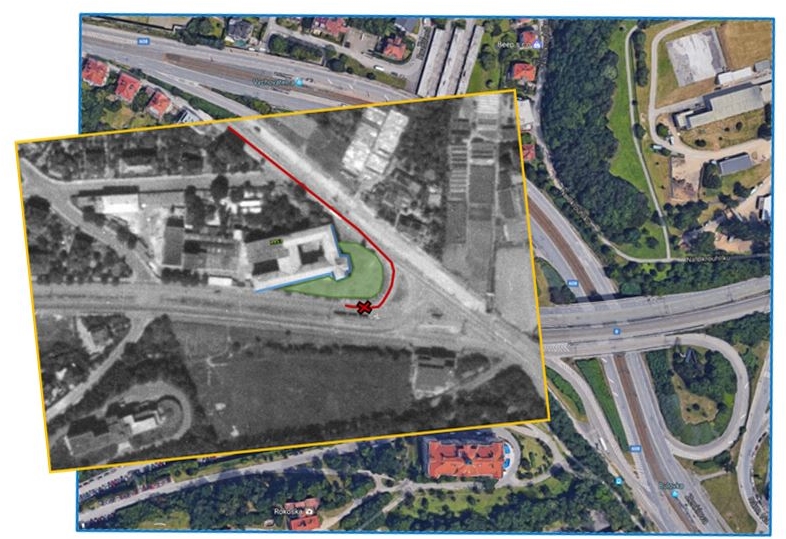 |
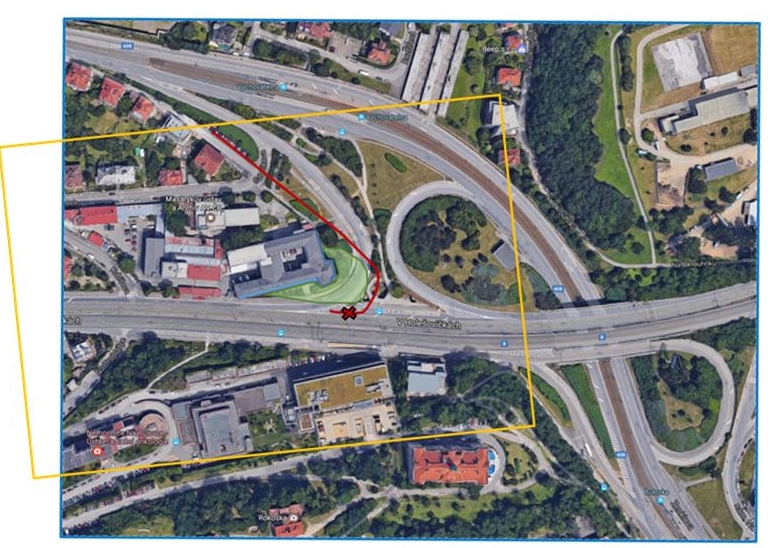 |
 |
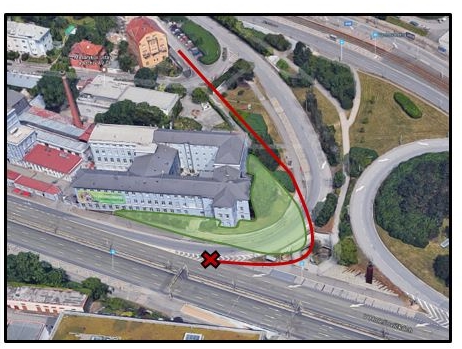 |
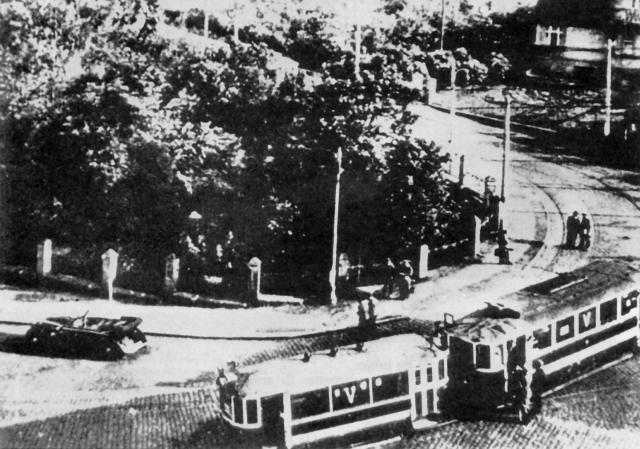 A modern memorial to the Czech patriots
stands at the triangle of green where the two slip roads meet.
A modern memorial to the Czech patriots
stands at the triangle of green where the two slip roads meet.
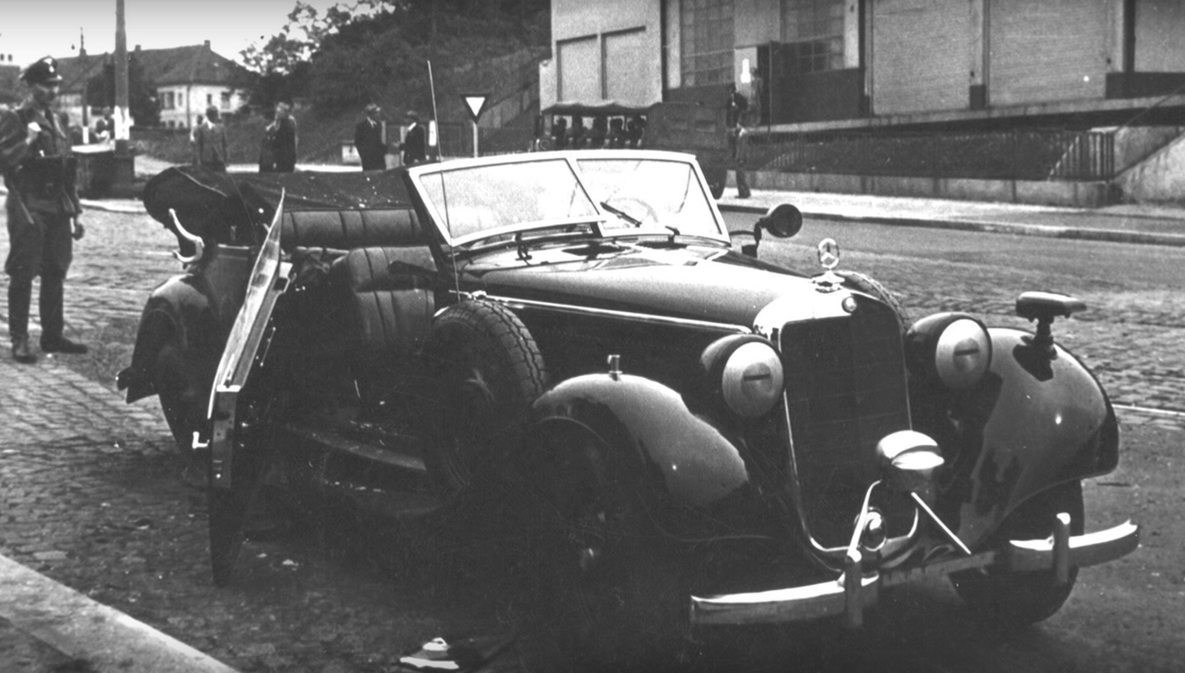
The 1942 view is opposite, taken after the attack. Heydrich's staff car is easily seen at the left edge of rhe frame. The photo above shows the damage caused by the bomb.
The car has recently been discovered.
SS-Oberscharfuhrer (Sergeant-SS) Klein, the uninjured bodyguard / chauffeur, was a formidable man. Opalka and Valcik escaped unnoticed; Jan escaped in one direction on his bicycle and having abandoned it outside the Bata shoe shop, was able to find sanctuary with the Novak family, a safe house.
Heydrich, who had pinned Jozef down with pistol fire, slumped against the bonnet of the car, too wounded to continue the fight, and ordered Klein to pursue Jozef. A Wild-West type running pistol battle ensued during which Klein's automatic pistol jammed. Fighting at close quarters, hand-to-hand in the doorway of a nearby butcher's shop, Jozef wounded him in the thigh and ankle, and was able to escape.
Heydrich's spleen had been fatally damaged and he had contracted blood poisoning from grenade shrapnel, seat-spring splinters, and horse-hair filling of the car's upholstery. There is mild evidence to suggest that the grenade was deliberately infected with chemical contaminants. He was taken to the Bulovka Hospital and treated by a German doctor who declined to remove his injured spleen, preferring to administer experimental drugs. These were unsuccessful and ten days after unsuccessful surgery, Heydrich died, in great pain. He was laid in state on the forecourt of Hradcany Castle before removal to Germany.
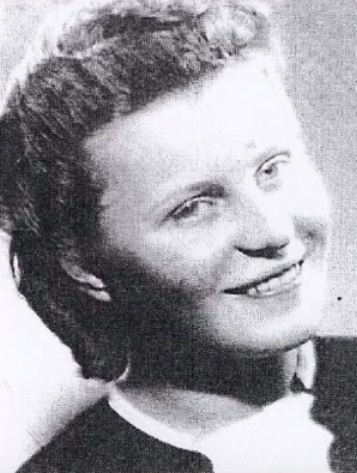 Mrs
Novak sent her young daughter Jindriska to
collect Jan's abandoned and bloodstained bicycle, but this led to her being
spotted and identified to the Gestapo. Jozef Gabcik
made his way to another safe house, that of Mr & Mrs Fafek,
who were Resistance fighters. He hoped after the war to marry their 19 year
old daughter, Libena (or Liboslava,
< left)
Mrs
Novak sent her young daughter Jindriska to
collect Jan's abandoned and bloodstained bicycle, but this led to her being
spotted and identified to the Gestapo. Jozef Gabcik
made his way to another safe house, that of Mr & Mrs Fafek,
who were Resistance fighters. He hoped after the war to marry their 19 year
old daughter, Libena (or Liboslava,
< left)
Opalka reached the flat of Mrs Tereza Kasperova, and Valcik found refuge with Mr Frantisek Sulek. Slowly the Resistance group pieced together the apparent chaos and managed to bring the parachutists together with a view to effecting their escape.
A terrible series of reprisals then followed. The Gestapo offered 10,000,000 Crowns for information leading to the arrest of the assassins, and eventually the parachutists were betrayed by two of their own team, Sgt Karel Curda and Cpl. Vilem Gerik. Kurda's motive for betrayal appears to be that he wanted to secure safety for his family from the wrath of the German response to the assassination. The Germans recovered enough evidence at the scene of the attack to allow them to identify key members of the Resistance, who were interrogated.
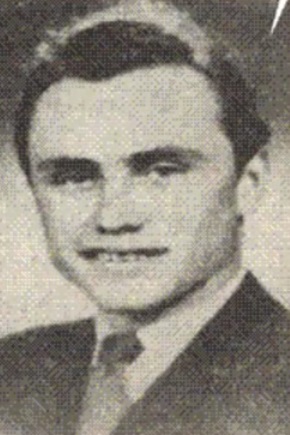 Previously,
and by accident they had also recovered a briefcase containing details of
Czechoslovak agents who were having false papers prepared, and armed with
this information, they pounced. Jan Zelenka
"Uncle Hajasky" committed suicide
when his flat was stormed by the Gestapo. "Tante
Marie" Moravec also swallowed a suicide
pill, but her husband and son Ata (> right) were taken.
Previously,
and by accident they had also recovered a briefcase containing details of
Czechoslovak agents who were having false papers prepared, and armed with
this information, they pounced. Jan Zelenka
"Uncle Hajasky" committed suicide
when his flat was stormed by the Gestapo. "Tante
Marie" Moravec also swallowed a suicide
pill, but her husband and son Ata (> right) were taken.
Ata, presented with his mother's head by the Gestapo, was tortured and executed. Her husband Alois, a railway worker, survived only until 24th October 1942, when he was executed in Mauthausen concentration camp, despite not having known of his wife's involvement wit the Resistance.
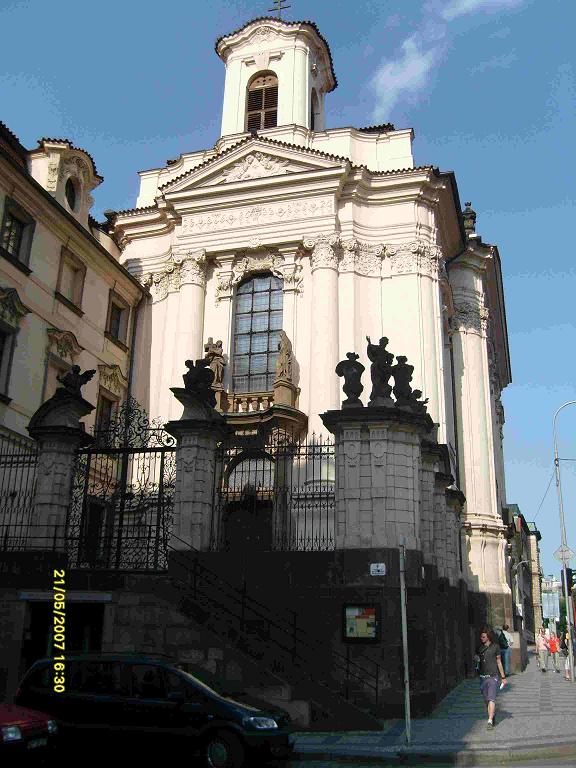 The parachutists (Opalka, Gabcik, Kubis, Pte. Jozef Bublik, Pte. Jan Hruby,
Pte. Jaroslav Svarc
and Valcik) took refuge at the Church of Sts.
Cyril and Methodius (Karel Boromejsky)
in Resslova Street, Prague, but the information
wrung out of Ata Moravec and Curda's
statements gave away the hiding-place.
The parachutists (Opalka, Gabcik, Kubis, Pte. Jozef Bublik, Pte. Jan Hruby,
Pte. Jaroslav Svarc
and Valcik) took refuge at the Church of Sts.
Cyril and Methodius (Karel Boromejsky)
in Resslova Street, Prague, but the information
wrung out of Ata Moravec and Curda's
statements gave away the hiding-place.
On June 18th 1942 the Germans under the command of Gestapo Chief Heinz Pannwitz and Nazi Secretary of State Karl Frank quickly overpowered the priest, Father Vladimir Petrek, and surrounded the church. The soldiers attacked, but they were held off for fourteen hours by the seven parachutists.
Church of St Cyril and Methodius, Resslova Street, Prague. Visitor area entrance is the dark door 'behind' the date and time stamp (it's closed on Mondays).
Paste 50.076935 / 14.416998 into Google Earth and use Street View to see the Church.
The Museum has its own web site
The bullet-scarred ventilation slot is adjacent to the pedestrian wearing the red shirt. The nearest subway terminal is a short walk up the hill, on the next block corner. Copyright Rob Davis
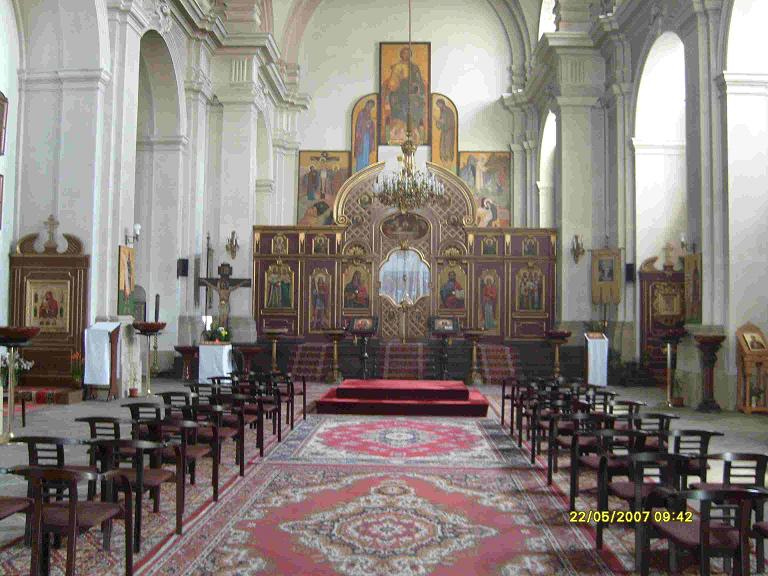
Church interior. The attackers entered from behind the wooden screen, with the three defenders firing into the church from the balconies above. The only entrance to the balcony area (directly above the camera) was a spiral staircase to the immediate left of the camera, with the square access hatch behind and to the left. The large stone slab blown up the the attackers to gain access to the crypt's stairway is under the red dias, and is now sealed. Copyright Rob Davis
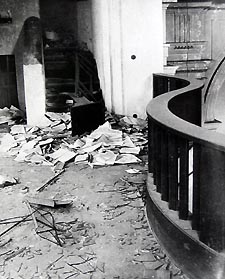 The trapped Czechs fought in the finest
of all traditions, and literally, with their backs to the wall. Lt.
Opalka was severely wounded in the fierce rifle,
pistol, submachine-gun and grenade firefight which
occurred in the body of the church and its balconies; he took a suicide pill
and shot himself through the head. The photo on the right shows the balcony
area immediately after the firefight was over. The
short staircase leads to the spiral stairway towards the body of the church,
this being the only way up or down.
The trapped Czechs fought in the finest
of all traditions, and literally, with their backs to the wall. Lt.
Opalka was severely wounded in the fierce rifle,
pistol, submachine-gun and grenade firefight which
occurred in the body of the church and its balconies; he took a suicide pill
and shot himself through the head. The photo on the right shows the balcony
area immediately after the firefight was over. The
short staircase leads to the spiral stairway towards the body of the church,
this being the only way up or down.
Jan Kubis and Bublik were both fatally wounded and removed to hospital by the Germans, but they both died without regaining consciousness. The Germans then discovered that the other four men, Valchik, Gabcik, Svarc and Hruby, were hiding in the crypt.
The square entrance-hatch was quickly discovered, but it was impossible to get men through it without them being easily picked off by the defenders.
The staircase entrance, covered by a large stone slab, was blown off its base and the attackers attempted to storm the crypt.
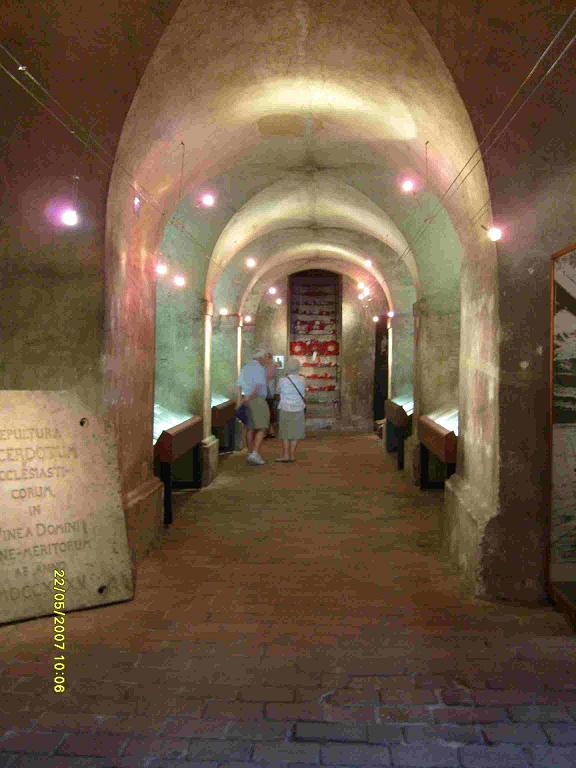 The Crypt and defended stairway
The Crypt and defended stairway
At least fourteen German soldiers were killed during the attempts to overpower the balcony defenders and whilst trying to storm the crypt via the entrance hatch. Attackers were easily picked off by the defenders, who hid from gunfire and grenades by retreating behind the pillars. Many more of the attackers were wounded. Further attempts to insert troops down the narrow stairway resulted in more casualties amongst the troops, and the Germans gave up, replacing the broken slab. For as long as the defenders' ammunition lasted, the Crypt was impregnable.
Pannwitz and Frank had Kurda brought in to try and persuade the men in the crypt to surrender, but his shouts for them to give themselves up were met by fire form the defenders’ guns.
Having accepted that the crypt could not be stormed, the Germans noticed that it was served by an external ventilation slot and fired into it from outside, leaving the wall and slot area pock marked with bullet holes. This did not affect the defenders, who were well away from the field of fire afforded by the narrow slot. The attackers then tried to fill the Crypt with first smoke, then water.
Finally, their Sten gun ammunition having been exhausted, and unable to succeed in a desperate attempt to tunnel their way to safety, the four men committed suicide with their pistols rather than be taken prisoner. 14 German soldiers had been killed and many more injured in the series of attacks.
photo copyright Rob Davis
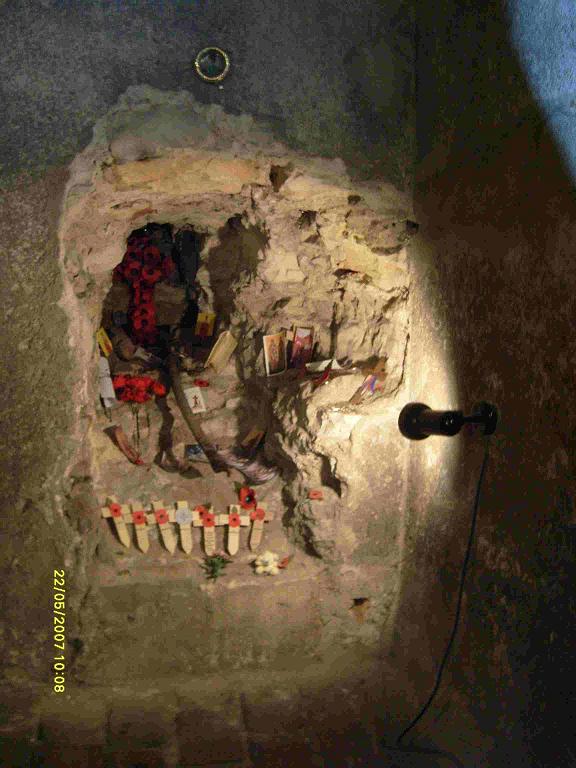
The attempted tunnel, directly underneath the ventilation slot.
Later it transpired that if the crypt defenders had started tunnelling during the battle in the church above, they would have probably escaped via the sewers. But at that stage in the fight they did not want to give away their position.
photo copyright Rob Davis

This photo (this and others reproduced with the kind permission of Dave Elliott) was taken in March 2011 and shows the view from inside the crypt, towards the ventilation slot. The attempted tunnel has been tidied up somewhat from when my photos were taken in May 2007.
photo copyright Dave Elliott
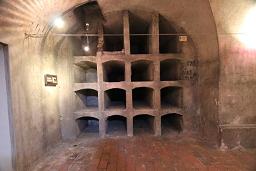
Dave's 2011 photo here shows the crypt's recesses for coffins and top left is the square entrance hatch, down through which the attackers tried unsuccessfully to introduce soldiers. It's such a small and awkward entrance that the defenders were easily able to pick them off as they jumped or were lowered through.
On the left wall is the modern museum's entrance, which was cut through post-war to afford visitors an easy way in!
photo copyright Dave Elliott
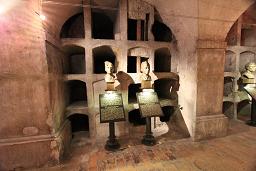
Busts and information panels on the defenders have much improved the Museum. I'd like to go back one day.
photo copyright Dave Elliott
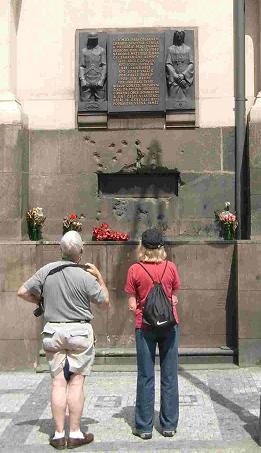
The bullet-scarred ventilation slot in the Church wall on Resslova Street. Note the memorial tablet and "1942" in the cobbles.
photo copyright Rob Davis
Visiting the Church and standing at the place where this all took place was the most profound visit of my entire life.
You can see some video footage of the Church exterior and Crypt interior on Youtube - do a search for 'Operation Anthropoid'. This video by Jørgen Elgård (Yogi) is particularly good, and very moving.
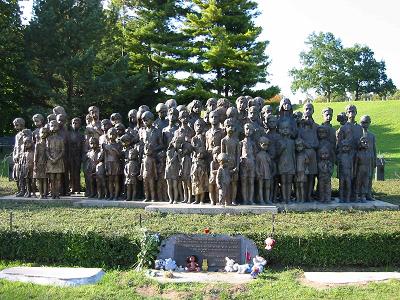 The assassination led to the reprisal
of the complete destruction of the village of Lidice, with the murder
of all the men; the women were taken to concentration camps and the children
were absorbed into Nazi homes and "re-educated". (Years later the
Red Cross and the International Tracing Service brought some of them back
to Czechoslovakia.)
The assassination led to the reprisal
of the complete destruction of the village of Lidice, with the murder
of all the men; the women were taken to concentration camps and the children
were absorbed into Nazi homes and "re-educated". (Years later the
Red Cross and the International Tracing Service brought some of them back
to Czechoslovakia.)
Andrew Mooney sent this striking photo (left) of the memorial to the Lidice children who died.
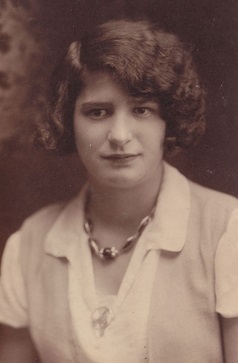
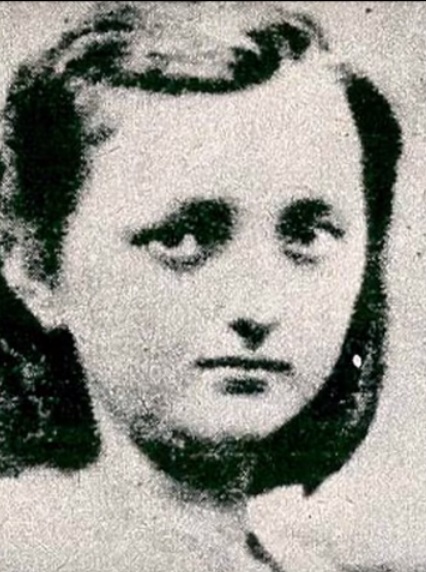 Jan
Kubis' girlfriend Anna Malinova (<
left) was arrested in the aftermath of the assassination, and
died in Mauthausen concentration camp. Her younger
sister Jindriska (right >) also
died in a camp. Anna was a war widow and her daughter, aged about 6 in 1945,
survived.
Jan
Kubis' girlfriend Anna Malinova (<
left) was arrested in the aftermath of the assassination, and
died in Mauthausen concentration camp. Her younger
sister Jindriska (right >) also
died in a camp. Anna was a war widow and her daughter, aged about 6 in 1945,
survived.
Many Resistance helpers were also arrested and murdered, including Father Petrek, although some such as Professor Jozef Ogoun and Ladislav Vanek "Jindra" escaped the Germans' wrath and after the war were able to give evidence against Curda and Gerik, who were tried for treason in 1946, and both executed.
Karl Frank was publicly hanged by the Czechs near Prague in 1947. Jim Jatras reports that there is a memorial to Fr. Petrek outside the church.
The Germans erected a monument to Heydrich which was torn down by the Czechs in 1945. Hitler granted Lina, Heydrich's widow, heavily pregnant at the time of his death, the estate at Panenske Brezany, and she ended her days as a hotel keeper on the island of Fehmarn. As for Heydrich's children, Klaus was killed after being run over by a truck in 1943.
Heider, the eldest, was either a member of the Hitler Youth and killed fighting the Russians in Berlin at the close of the war, or he survived the war and along with his mother, Lina, and two sisters. Further information is welcomed.
Jan came from the Trebic district of Moravia and was 29 years old in 1942. Jozef Gabcik was a former locksmith. Both were professional soldiers, Sergeants in the Czechoslovak army, and both were decorated in the early days of the war and fled to England via Poland and the French Foreign Legion. Jan was particularly noted for his expertise with explosives. They were befriended in England whilst they were training and were frequently house guests of the Ellison family at Ightfield, Shropshire. The Parish Council declined my suggestion that the names of these two brave men be remembered on the village war memorial, Ightfield being the nearest place they had to "home" whilst they were in England. I think that this is a great oversight, although these men, and other Czechs who fought in exile against the Germans, are remembered on a very plain and uninspiring memorial in the grounds of Cholmondeley Castle, Cheshire.
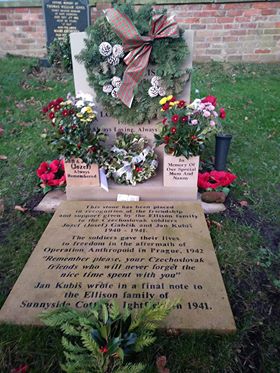
I was very pleased to hear that a memorial has been added to the grave sites of the Ellison family at Ightfield. The unveiling was on July 23rd 2017, following a memorial service at the church.
I take this opportunity to salute these brave men, who were patriots of the highest order, and whose loyalty to their country and themselves merits recognition. To quote Sir Arthur T Harris, Commander-in-Chief RAF Bomber Command, "If there is a Valhalla ... such men will be there ... seated far above the salt." He was speaking of Guy Gibson, but the sentiment is identical.
The GPS location for this grave and memorial is 52.943634 / -2.608451.
Post war
It is interesting to note that a CIA Analyst, R C Jaggers wrote two articles in the early 1960s which were declassified in 1993. One is a criticism of the Burgess book and another an account of the assassination plan and its aftermath. Jaggers discounts much of Burgess' book as "the usual embroidery of verbatim dialogue which no still living person could have heard" and although praising him for revealing the correct name of Karel Curda (instead of Alois Kral) as the primary traitor, metaphorically tosses the book aside as a "disservice to the cause of careful history". Jaggers analyses the recruitment and specialised training of Jan Kubis and Jozef Gabcik, himself adding the same type of "verbatim dialogue". His and Burgess' accounts differ very widely, Jaggers claiming that the agents parachuted into Czechoslovakia were strictly instructed to act alone and without assistance from or contact with the Czech Resistance; Burgess making it clear that substantial assistance was given by the local Czechs.
Personally, I cannot see how parachutists inserted into Prague could possibly have effected the assassination without help from local Resistance workers, and for Jaggers to suggest that the seven parachutists assembled by chance in the Church at Resslova Street is completely unbelievable. He also states that he has no knowledge of the second traitor, Gerik. He does not mention Burgess' account of the love affair between Kubis and Anna, or Jozef and Liboslava, which on-the-ground research would certainly have revealed.
There are other flaws in Jaggers' analysis. I think you have to treat many tracts of Burgess' book as faction, which nevertheless makes it a good read, and his empathy with the "Seven Men At Daybreak" is complete. Faction is fine with me, provided that the account is consistent with verifiable events and the nature of the personalities involved. Burgess would certainly not be the first author of historical accounts to use this device.
I invite either author (or interested parties) to comment.
Here is one subtle fact on the 1976 film, which is itself discussed a little lower down this page. Martin Shaw, in playing the part of Karel Curda, is brought under arrest to the pavement outside the Church in Resslova Street and faced with the bodies of the three men (in reality these were Opalka, Kubis and Svarc) killed in the first firefight on the balcony. He names two of the bodies as "Bublik and Svarc" and the third as "Kral". Curiouser and curiouser ... did the film-makers know of the initial mis-identification of Karel Curda? As Burgess wrote the screenplay, was this a sly dig at Jaggers?
Paratroopers' grave discovered
Prague, Oct 3 (CTK) [sorry - I don't which year this was printed] - Jan Kubis and Jozef Gabcik, the wartime Czechoslovak heroes who murdered [sic] Nazi Reichsprotector Reinhard Heydrich, are buried in anonymous pits at Prague's Dablice cemetery, a year-long research has confirmed, the daily Mlada fronta Dnes (MfD) writes Wednesday.
Paradoxically, the two paratroopers, along with their colleagues within the anti-Nazi resistance, who all finally committed suicide in a cache before the Gestapo could catch them alive, are buried in Dablice along with Karel Curda, a traitor who reported their cache to the Nazis, the daily writes.
High-ranking German and Czech pro-Nazi officials who were executed as war criminals after the war are also buried in Dablice, as well as victims of the Czechoslovak communist coup of 1948, the paper says. "We checked the testimonies of witnesses and past recordings of the Prague Cemeteries' Management, including the Institute of Forensic Medicine," says Ales Knizek, head of the Czech Military Historical Institute that organised the research. The researchers also gained valuable help from a private explorer who in the 1980s recorded the testimonies of former doctors and police officers well acquainted with the Nazi "technology" of freedom fighter burying, who, however, have died in the meantime.
Emanuel Vlcek, leading Czech anthropologist, who worked in the Forensic Medicine Institute during the war and who died one year ago, confirmed to MfD shortly before his death that the remains of victims from among Czechoslovak freedom fighters had been buried in Dablice. "If this [the paratroopers' undignified burying] is true, it is a huge shame and something must be done about it," Czech Senate deputy chairman Jiri Liska (Civic Democrats, ODS) told MfD previously still before the research confirmed the suspicion.
Liska says that in negotiations with the Dablice district hall he pushed through the plan to erect a monument to the late paratroopers and other freedom fighters. It is to be unveiled on October 28, the anniversary day of the establishment of Czechoslovakia in 1918, which is a public holiday, MfD writes. Apart from Kubis and Gabcik, a duo known under the codename Anthropoid, Dablice is also a burial place of Alfred Bartos, Jozef Valcik and Jiri Potucek (paratroopers from the Silver A operation), Adolf Opalka (commander of the Out Distance paratrooper group), freedom fighter Vaclav Moravek and Marie Moravcova, who hid the paratroopers from the raging Gestapo, MfD writes.
Those buried along with them include Karl Hermann Frank, a Nazi leader who decided that the central Bohemian village of Lidice be razed to the ground in June 1942 in retaliation for the death of Heydrich, the Reichsprotector who planned the Czech nation's liquidation.
Scottish Memorial at Arisaig
At various times, Resistance paratroopers were trained at Arisaig in Scotland, where several memorials commemmorate the operations and personnel concerned. Thanks to Robert Coyle for the photos. There are additional web pages here and here.
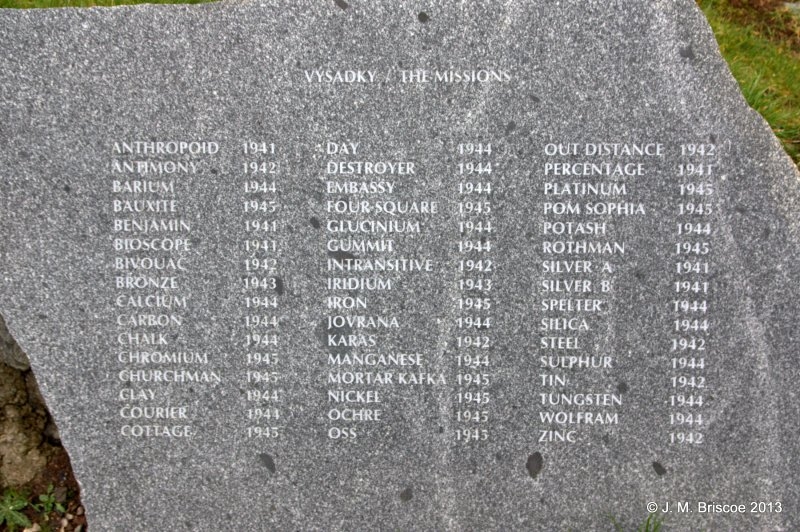
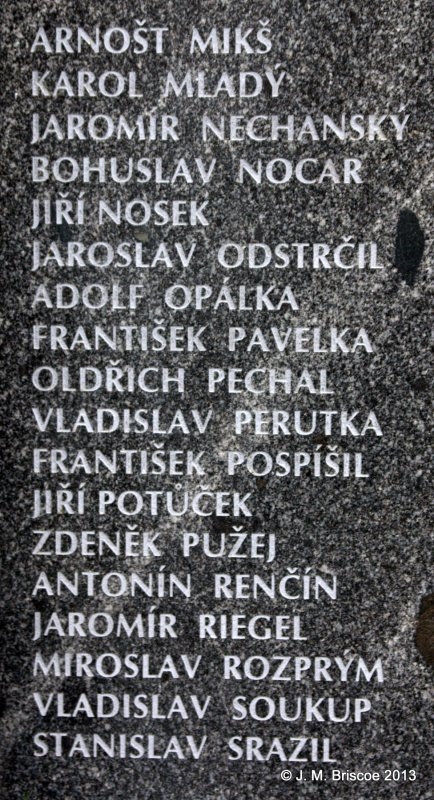
Thanks to Mark Miller, David Oldman and George Lengol for additional information; further information is welcomed. I do have a copy of "Seven Men At Daybreak" by Anthony Burgess. George visited Prague and filmed the church. He has also visited the assassination site "V Holesovickach in the Liben district of Prague" and reports that it is inevitably rather different after 50 years, but recognisable. He and his wife hope to visit again in 1998. He also says "From what I read, a mass is held every June 18th at the church in remembrance of the event. We were there on June 25, '94 and I was impressed with all the floral arrangements placed on the sidewalk in their honour--52 years later."
David Oldman reports that most Czechoslovak statues of Lenin and Gottwald were smelted down at the fall of communism. The resulting metal was sculpted into an avenue of statues at Lidice, to commemorate all of the 79 dead children of Lidice; the sculptress herself was one of the survivors. These statues were based on contemporary photos of the children.
The German boast that Lidice was erased from the map was proved false. Several towns around the world renamed themselves "Lidice" in memory of the Czechoslovak massacre.
Natasha Traupmann advises that “With regard to the fate of Heydrich's three surviving children (as of 1943), Charles Wighton states that his older son, Heider, was released from Hitler Youth duties after a complaint to Himmler by Lina Heydrich, and survived the war. His two sisters, Silke and Marte, also lived to see the end of the war. Off a tangent, there has been a claim that Thomas Heydrich, Heydrich's nephew, was so traumatized by the deeds of his infamous uncle that he had to join a support group consisting of children of other prominent Nazis. Charles Whiting (not to be confused with Wighton) states that for some time this nephew went around to schools singing songs in Yiddish, and his father, upon reading some notes left to him after Heydrich's death, enlisted for the Eastern Front immidiately and was killed. Whether this information is reliable is uncertain, as Whiting gives Heydrich's brother's name as Thomas Senior, and not Heinz.”
A Daily Mail news article in March 2011 stated that Heider had plans to restore and renovate the castle where his father had lived.
Further reading:-
After The Battle Magazine, Issue No 24. Church House, Church Street, London E15 3JA UK. 0181 534 8833. Fax 0181 555 7567. An excellent read, full of useful information and photographs.
"The Killing of SS-Obergruppenfuhrer Reinhard Heydrich" by Callum MacDonald, ISBN 0-333-44908-8 Macmillan London Ltd (1989), 4 Little Essex Street, London WC2R 3LF. I have recently obtained this book from my local library and would say that it is excellent, thoroughly researched and very descriptive.
"The Assassination of Heydrich" by Jan G Wiener. Grossman Publishers, New York 1969
There is also a novelised memoir by the well-known Czechoslovak writer Jiri Weil, 1900-1959, published first in Czechoslovak as NA STRESE JE MENDELSSOHN in 1960, then as MENDELSSOHN IS ON THE ROOF, in 1991, translated by Marie Winn and published by Farrar Straus Giroux. This covers another topic about the German occupation, but the assassination is covered in the text.
"Target: Heydrich," by Miroslav Ivanov.
A Biography, "Heydrich: Hitler's Most Evil Henchman," by Charles Wighton.
"Reinhard Heydrich" by Eduord Calic available from B Salinger The American War Library Published by William Morrow & Co. ISBN 0-88029-210-5.
There was also a movie made about Heydrich's death, "Hangmen Also Die," in 1943. I haven’t seen this, but David Swanston says of it : "Hangmen also die " is a “Yankee - quota quickie" starring (of all people!) Brian Donleavy as a "Killer" on the loose in a central European city. Who was responsible (script, direction etc) for this travesty of the Heydrich story I am not aware but would like to know so that they can been excoriated, burnt in effigy etc.” Marshall Grossman says "The film is certainly not historical, but it serves its propaganda and inspirational purpose extremely well. The "culprits" are no less than Fritz Lang and Bertold Brecht. Seeing the film (yesterday) is what sent me to the internet to find the real story and so to your webpage, for which-thanks."
The films : 2017 "the Man with the Iron Heart" : 2016 "Anthropoid", 1976 "Operation: Daybreak" and 1964 "Atentat" (Czech for assassination)
The Man With The Iron Heart (2017)
This has its IMDB page here. Having watched it, I'd say that the portrayal of Heydrich in the first half of the action is historically accurate and good viewing, as it shows his military history - I won't give the game away - and his relationships with colleagues, subordinates, superiors as well as friends and family. His rise to 'Protector of Bohemia and Moravia' and how he fulfils this role is shown very graphically.
The story also covers the assassination attempt, and its instigators. However after the failed attack on Heydrich, the film goes completely off the rails. Great liberties are taken with the actual facts of the events and the people concerned, and once the scenes move to the church where the parachtists are trapped, the sequences bear little or no relation to the truth. In particular, the weaponry shown as being used by the seven parachutists is a farce. Thompson .45 calibre submachine guns? A Bren gun? Oh dear me ... and the ending is fantasy, more in line with 'Operation: Daybreak' than what actually occurred in the church, which incidentally is nothing like the actual location. For me, that part of the film was an insult to the memory of the real people concerned.
So - watch the first 2/3 of the movie and then - find something better to do.
Anthropoid (2016)
Although my local Shropshire cinemas were initially not going to show the film, they had a change of mind when informed of the County's association with the training of Czech soldiers and especially the relationship of Kubis and Gabcik with the Ellison family in Ightfield. Consequently I was able to see the film on September 26th 2016. IMDB page here.
Whilst being prepared to be vaguely disappointed, half-expecting a "Hollywoodsation" of the story, in fact I was very much impressed by the film, and recommend that you go and see it, either as one who is interested in the Anthropoid story or simply as an exciting movie.
The film begins as Jozef and Jan land by parachute. These is a short fictional passage at this stage in the story - I won't give the game away - but apart from this, the accuracy of the movie is astonishingly good. In particular the friction between the local Czech Resistance group and the parachutists is well portrayed, as they argue about what effect the assassination would be likely to have on the Czech population. Human frailties are also shown, as is the tension and excitement of planning the attack.
There are small and unstated snippets which show that the film has been well researched, notably as Heydrich collapses after the grenade explosion, a close-up of the damage to his seat's upholstery demonstrates that it was the septicaemia from the seat's horsehair filling which brought about his death. Another short clip shows that as Jozef is preparing his Sten gun half-inside the briefcase, a short piece of straw is shown against the weapon.. The Germans found the dropped Sten and established that this piece of straw was what had caused the misfire.
Attention to detail is thoroughly excellent throughout the movie, even down the the correct use fo the Colt .32 automatic pistols used by the parachutists, and the modified grenades.
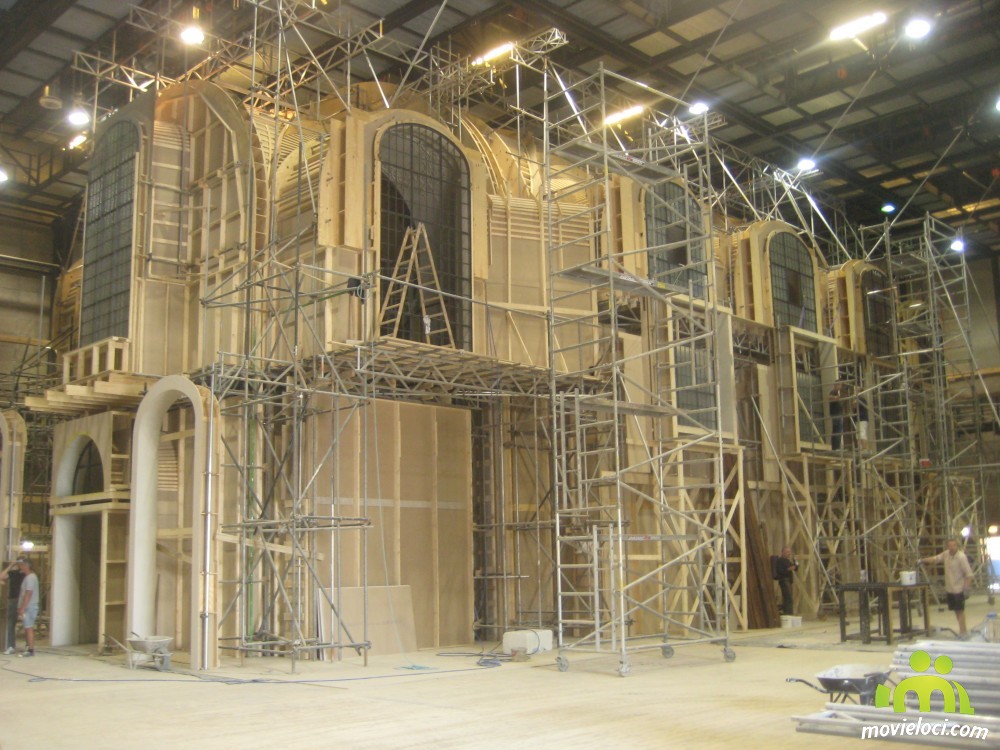 In particular, the
firefight in the church as quite amazing. The set-makers have produced a perfect
copy of the church's interior, and being familiar with it I can state that
I have never seen a better reconstruction.
In particular, the
firefight in the church as quite amazing. The set-makers have produced a perfect
copy of the church's interior, and being familiar with it I can state that
I have never seen a better reconstruction.
Well, done, movie-makers, you have made an outstandingly fine tribute to the bravery and courage of the Czech Resistance workers and the "Seven Men At Daybreak". I'll look forward to buying the film on DVD and watching it again.
< the movie set 'church' under construction
I would be pleased to receive comments from anyone involved with making the film, or from those who have seen it. You can email me here, remember to delete the extra 'z' in the email address.
GO AND SEE THIS MOVIE!
Meanwhile, here is a preview. The movie is reviewed about half way through the BBC 'Front Row' radio programme of September 7th 2016. The Dail Mail has a review here.
Operation : Daybreak (1976)
|
The 1976 film "Operation: Daybreak" (IMDB page here) starring Timothy Bottoms, Anthony Andrews, Martin Shaw, Anton Diffring, George Sewell etc, was a good representation of the events, although some dramatic licence was taken at the end, Jan and Jozef portrayed as being the last two defenders of the crypt. Ars Gratia Artis. The assassination site was not the original location. The music, one of the first film sound tracks to be entirely electronically produced, was very striking, especially during the church battle scenes. The film appears to be a close parallel with a 1964 Czechoslovak-made black-and-white version called ATENTÁT, with some scenes staged identically. Here is a clip from 1976 "Operation : Daybreak":- http://www.youtube.com/watch?v=FhpSaQ05Nts I am extremely saddened to report that Nicola Pagett (opposite), who portrayed Anna Malinova in the film, died unexexpectedly aged 75 on 3rd March 2021, as a result of a brain tumour. Her IMDb entry is here. Film buffs may not know that as well as appearing in the TV series "Upstairs Downstairs" and many others, she played the Princess Mary in "Anne of the Thousand Days" (1969) starring Richard Burton and Genevieve Bujold. |
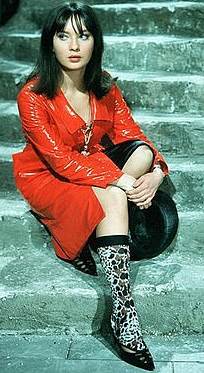 |
Many thanks to Ken Edgecombe who in September 2011 most kindly sent me a DVD copy of the Atentat film. It seems particularly well put together and despite not being able to understand any of the dialogue, I thought it was well worth watching. A synopsis of the film states that "While the film’s culminating battle scene is set in the church, the interior of the building was actually reconstructed in the studio on a 1:1 scale for the film. Every detail of the church’s interior were recreated. The designers carefully selected and studied an enormous amount of materials. They visited the Czechoslovak archive and spoke with members of the British army. They even tracked down staff who worked at the villa at Panenské Brežany, where Reinhard Heydrich lived. The then-communist regime demanded that the film present the Communist Party as behind the event. However, director Jirí Sequens refused. Work on the film was then interrupted for four years. Creator and screenwriter: Miroslav Fábera, Kamil Pixa, Jirí Sequens. Cameraman: Rudolf Milic. Architect: Karel Lier. Music: Miloš Vacek. Director: Jirí Sequens."
The 1964 film (IMDB page here) uses the original assassination location at the sharp bend, but the 1976 one does not. Both films use the actual church for outdoor and some indoor sequences, and in the British version, a sacking-covered modern triangular road traffic sign is clearly visible as George Sewell and some German soldiery dash about the street! It also uses many outdoor location sequences and the interior scenes during the battle appear to have been filmed in an extremely well made set which is an almost perfect match for the real interior; the setmakers have paid a fanatical degree of attention to getting it right. It is only by freeze framing the battle scenes and comparing them to photos of the real church that very insignificant differences show up.
Both versions have views of the street outside the Church and today these have changed substantially. Gone are the tram lines and overhead power cables; modern traffic comes from the bridge over the Vltava, a stone's throw away. The building on the adjacent block corner (opposite the Museum entrance) is a bar/cafe. Entrance to the Museum is from a new doorway cut under and between the double set of steps leading to the main Church entrance, with the actual Visitors' Museum directly under the patio area and a special visitor's doorway cut from the Visitors' area into the crypt to give access.
The crypt and ventilator sequences seem to be a mixture of location and studio, again with a degree of accuracy which borders on the fanatical. Such differences as there are, certainly can't be noticed under normal viewing conditions. I can't believe that the real church was used for the battle scenes, as so much was blown up or shot (notwithstanding the special effects boys). In particular, a scene where fire being returned by the attackers using MP40 machine pistols rips apart the wooden balcony rail and plastered walls, behind which the defenders are taking cover.
Dmytro Doblevych says (May 15th 2020) "Did you know there is at least one more film featuring assassination of Heydrich? It's called "Sokolovo" (1975). The assassination is not its main theme, yet Czech people comment that it's probably the most true-to-life depiction. You can watch the clip here."
This film clearly uses the original assassination site on the famous 'Anthropoid Corner', before the road layout was changed to the current view.
There was also a documentary made in 1992 by Sunrise Productions and shown on TV. This was historically accurate and contained some cine footage of the participants as well as the Czechoslovak film excerpts mentioned earlier. Its title is "SS - 3 The assassination of Reinhard Heydrich" and its is available from DD Video, Chester, UK, price GBP 10.99, run time 56 minutes. Tel 01829 741711 or fax 01829 741862. Scripted by Callum McDonald, it is well done and worth buying. In the video are some clips from the original Czechoslovak film and many scenes have been matched in the 1976 version.
One correspondent says "You can visit the mansion near Prague where Heydrich lived. It's now a home for pensioners. you can't go inside, but you can stand outside the gate. It's quite lovely."
A
Prague news article published in 2007 stated that the assassination site no
longer existed - although streets around the area have been named after Kubis, Gabcik, Opalka and Valcik.
There
is an excellently prepared Youtube video on
the Heydrich Assassination.
Heydrich in film
My Internet correspondent Frank Ruddock says : "As you may be aware, there is another film which portrays Heydrich during the same period. It is the Wannseekonferenz [RD : the English version is called "Conspiracy"] dating from 1984 and starring Kenneth Branagh as a stunningly lookalike Heydrich]. I have the German version, with a brief narrative introduction in English (less than a minute) and then English subtitles; I believe there may be a dubbed version, but it would be second best, losing the authenticity. The film is an exact recreation of the January 20, 1942 Wannsee Conference held in Berlin. Critics hailed the film as meticulously accurate, with evocative period detail, similar qualities you have noted with Operation Daybreak. Heydrich chaired the meeting, Adolf Eichmann at his right hand, with a dozen key bureaucrats to make the "final solution" for the Jews of Europe happen. "What had been tentative, fragmentary and spasmodic, was to become formal, comprehensive and efficient" (from a German observer, quoted by Callum MacDonald on p. 41).
The film is precisely the same length of meeting (85 minutes), and because the minutes and conclusions were recorded and discovered after the war, the discussion is as it occurred. The actors playing Heydrich and Eichmann are dead ringers, which completes the feeling you are in the room. What emerges is a frighteningly normal, bureaucratic meeting, with Heydrich ensuring that all happens as wished by the SS. The bureaucrats are only too obliging. Because both films are historically accurate portrayals of Heydrich and other participants at key events, seen together they constitute a grim "life and times" of his last few months. Both are well directed and acted, with an attention to detail that increases the impact. Both capture, with an almost dispassionate eye, the "normalcy" of Heydrich and the Nazi system, i.e. these are not lunatic monsters but are readily recognizable people. This is closer to the historical reality.
In the Wannsee Conference, one first sees Heydrich in his role as the most powerful security official of the Reich-one can make the case he was close to eclipsing Himmler-organizing mass murder on an industrial scale. Then, in Operation Daybreak, a few months later, one sees Heydrich in his new and more politically significant role as Reichsprotektor of Bohemia and Moravia. He is using the same brutal methods, but now directed at achieving the SS's plan to take its "state within a state" ambitions to the logical conclusion of governing Germany in law as well as fact, supplanting even the Nazi party."
It is noteworthy that two British officers, Major Ronnie Littledale and Lieutenant Michael Sinclair, who had escaped from a P.O.W. camp in North Poland, were caught in Prague as a result of the huge hue-and-cry after the assassination. After this event they were sent to Colditz Castle in Saxony, the Straflager or "Naughty Boys Camp". Sinclair, known to his captors as "Der Rute Fuchs" (the Red Fox), was (genuinely) shot whilst trying to escape in 1944. Another RAF escaper, S/Ldr Roger Bushell, was also caught in the aftermath of the assassination; his Czechoslovak RAF officer co-escaper, Jack Zafouk, was also sent to Colditz, and the Czechoslovak family sheltering them were all executed by the Gestapo. Bushell developed a grinding hatred of the Germans and eighteen months later, masterminded the Great Escape from Stalag Luft 3, Sagan. He was one of the 50 escapees murdered by the Gestapo.
In mid December 2019 it was reported that Heydrich's unmarked grave in Berlin had been opened and disturbed, although seemingly nothing was removed. It is likely that the culprits had inside knowledge on the exact location, in order to be able to accurately find it. Afterwards the grave was refilled. The location is 52.532195 / 13.371703, mapped from the various photographs of the grave's disturbance.
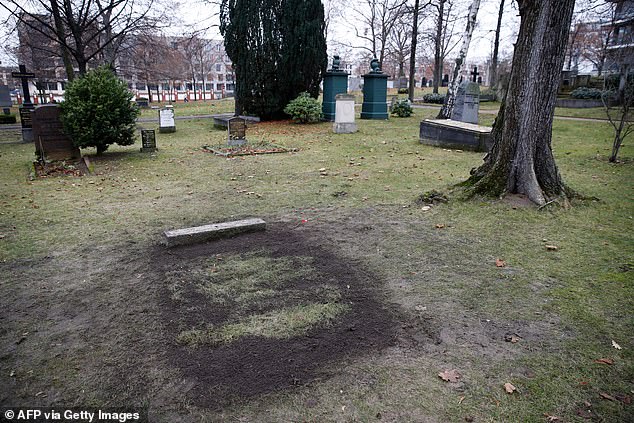
A Google Earth Street View also shows the location:-
